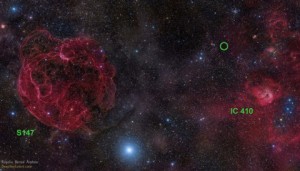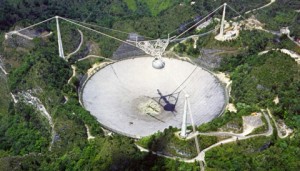A newly discovered radio burst places these ultrafast, ultrabright pulses on the cosmic map of unknown phenomena.

An optical sky image of the area in the constellation Auriga where the fast radio burst FRB 121102 (green circle) has been detected.
Rogelio Bernal Andreo (DeepSkyColors.com)
Every so often things go bump in the quiet cosmic night, releasing a rush of energy in a few thousandths of a second and leaving astronomers mystified. One of these bumps came to light last year, when astronomers announced the discovery of four brief but bright bursts of radio waves.
All four bursts were discovered over the course of a year at the 64-meter Parkes radio telescope in Australia. Before that, two others were spotted with the Parkes scope, one in 2007 and a weaker candidate in 2012.
The lack of any similar findings by other facilities led to speculation that these bursts might have been signals originating from sources on or near Earth.
But a new detection of one of the so-called fast radio bursts with the Arecibo Observatory helps “eliminate any doubt that these radio bursts are truly of cosmic origin,” said coauthor Victoria Kaspi (McGill University, Canada) in a press release. It also sheds light on the mysterious phenomena that may be behind these exotic bursts.
Extragalactic Origins?
Fast radio bursts (FRBs) have a distinct look to them. Besides only lasting a few thousandths of a second and releasing as much energy as the Sun will take 10,000 years to emit, their lower frequencies arrive noticeably later than their higher ones. This delay is due to plasma dispersion: through any medium, longer-wavelength radiation moves slightly slower than its shorter counterpart.
Light from extragalactic objects travels through intergalactic space, which is teeming with electrons in clouds of cold plasma. The farther the light travels, the more electrons it will have to travel through, and the greater the time delay between the arriving wavelengths. By the time the light reaches Earth, it has been dispersed by an amount that is directly correlated with distance.
Using the spread in the FRBs’ signals, astronomers calculated that the bursts likely originated anywhere from 5 to 10 billion light-years away.

The Arecibo 305-meter radio telescope in Puerto Rico.
NAIC
The latest burst was detected on November 2, 2012, at the Arecibo Observatory, which boasts the world’s largest radio telescope, with a dish spanning 305 meters. The burst was spread out three times wider than would be expected from a source within our galaxy. So the team thinks this set of radio waves came from a cosmological distance.
But just what is releasing the radiation remains a mystery. “The origin of these bursts is still highly uncertain, and it could turn out to be some new, exotic object no one has imagined before,” says lead author Laura Spitler (Max Planck Institute for Radio Astronomy, Germany).
Coauthor Jim Cordes (Cornell) fantasizes that FRBs could be evaporating black holes or even cosmic strings. “However, my bet is that they have something to do with neutron stars, which have provided us [with other] well known (but not completely understood) bright pulses,” he says. “I hope I lose that bet.”
Neutron stars might be able to produce the pulses when they merge with each other. In the final milliseconds before the merger, the stars’ rotation periods and magnetic fields synchronize. Energetic charged particles would spiral along the strong magnetic field lines and emit a beam of radio radiation that would only persist for the few milliseconds remaining before the collision. Such a burst would be detectable across intergalactic space and explain both the duration and strength of these enigmatic signals.
Or do they originate a little closer to home?
Other astronomers think these bursts need not be exotic events at cosmological distances. Several months ago Abraham Loeb (Harvard) and his colleagues suggested that FRBs might instead be eruptions from flare-prone stars in the Milky Way.
If a thick envelope of plasma encased the stars, the electrons in these stellar coronas would be tightly packed enough to create the same observable effect as passing through billions of light-years of intergalactic medium, the team argues.
But neither Spitler nor the team who reported the four FRBs last year finds this argument convincing.
“I can’t say that for certain our burst isn’t from a galactic source, such as from a stellar corona,” says Spitler. But she thinks an extragalactic origin is sounder: if FRBs come from within the Milky Way, they should be concentrated along the galactic plane, yet most have appeared far from it.
But Loeb argues that if the flaring stars are located within a distance smaller than the thickness of the galactic disk, it makes the above argument meaningless.
“When you look at the brightest Sun-like stars in the night sky, you see that they cover the sky uniformly,” says Loeb. “The reason is simple: in our galactic neighborhood the distribution of stars is roughly uniform around us. Only when you look at sufficiently faint stars (which are located at distances larger than the height of the disk), you find that they reside in a preferred strip across the sky.”
Cordes also argues that although the spread in FRBs’ signals might look similar whether they originate at cosmological distances or within stellar corona, the latter would add other effects that are not seen.
So whether or not these signals originate from cosmological distances or within our own Milky Way depends on whom you ask. The study of other astrophysical phenomena, namely gamma-ray bursts and neutron stars, has also played out in this pattern.
While astronomers have only detected a handful of FRBs, they estimate that they might occur roughly 10,000 times a day over the whole sky. Efforts are now under way to detect radio bursts at other facilities. And future observations should settle the debate, helping us to better understand these enigmatic pulses.
References:
L. G. Spitler et al. “Fast Radio Burst Discovered in the Arecibo Pulsar ALFA Survey” The Astrophysical Journal, July 10, 2014
Abraham Loeb et al. “Fast Radio Bursts May Originate From Nearby Flaring Stars” Monthly Notices of the Royal Astronomical Society, January 2, 2014
T. Totani “ Cosmological Fast Radio Bursts From Binary Neutron Star Mergers” Publications of the Astronomical Society of Japan, October 25, 2013
D. Thornton et al. “A Population of Fast Radio Bursts at Cosmological Distances” Science, July 5, 2013
Learn more about the mysteries of our universe with our special issue, Astronomy's 60 Greatest Mysteries!
 1
1









Comments
Gregg-Weber
July 19, 2014 at 11:31 pm
Are they from the same direction?
Is there a time step, where some of these only occure at an equal length of time from eachother as caused by rotation and/or revolution?
Would it be feasible to have other Arecibo telescopes north & south to cover those areas outside the sight of Arecibo?
If a beam, if the width can be found then there is a clue as to how many there are in every direction.
Also are they all equally (sort of) far distant away from us and not of random distances (equal volumn) then this could be something associated with the primitive (and not ours) universe.
As far as galactic source, are these near the galactic plane? Just read on to the answer. If far from galactic plane then would the galactic material jam or block any signal making it hard for a galactic source to be heard?
Can these signals pass through the ionization wall from some further point associated with another Big Bang elsewhere and before ours?
As you can tell, I am typing as I read.
You must be logged in to post a comment.
You must be logged in to post a comment.